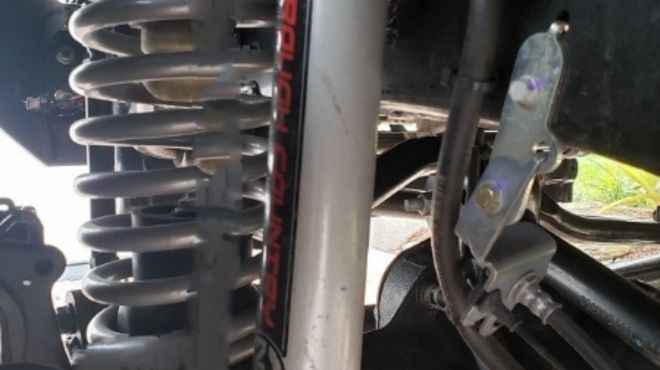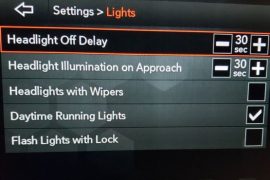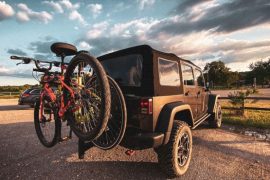Determining the lift height for your Jeep is made simple by following a few key steps. All you need to do is to park on a flat surface, use a tape measure to find the distance from the center of the axle tube up to the lower edge of the fender flare, compare that number with your vehicle’s factory specifications, and the difference between those measurements will reveal your lift size.
As an alternative to measuring the lift yourself, you can contact the manufacturer of your Jeep’s lift kit by locating their logo and unique serial number somewhere on the installed parts and then calling their customer support line to inquire about precise sizing specs.

I’ll give you a straightforward guide on measuring Jeep lift size yourself in your garage or driveway, no fancy tools required. You’ll know precisely how much higher your baby rides compared to stock.
Can You Measure Jeep Lift Size on Your Own?
Determining a Jeep’s lift height yourself is a pretty straightforward process – no need for complex tools or taking it to a shop. Just make sure your Wrangler or Cherokee is parked on a flat, level surface first and foremost. You want an accurate measurement, not one complicated by unbalanced crossover angles from being at an incline.
The next vital step is looking up the factory shock measurements for your particular Jeep make, model and year. This info can easily be found with a quick Google search for “stock [year] Jeep [model] shock height.” For example, if you drive a 2022 Jeep Wrangler Sport S, you would search for “stock 2022 Jeep Wrangler Sport S shock height.”
This will tell you the original out-of-the-box suspension height set by the manufacturer. You’ll need to know this number to compare with your current measurements, making it possible to calculate current lift size. So be sure to note the stock shock height for your ride’s specifics before moving forward.
How to Measure Jeep Lift Size?
Once you’ve parked on level ground and looked up the factory shock height, it’s time to grab a tape measure. You’ll want to measure the distance between the center of the front axle tube and bottom edge of the fender flare on each side. Make sure to bend down and position your eyes directly in line with the tape to get an accurate measurement.
Jot down each measurement from side to side. Now comes the moment of truth – take your current measurements and subtract the OEM stock shock height you found earlier. The difference between those numbers is your Jeep’s lift size.
Let’s take an example of someone measuring their Jeep Wrangler. They look up that the stock shock height is 10 inches from the factory. When they measure from their axle tubes to fender flares, they get 15 inches on each side. Take the 15 inches measured and subtract the 10 inch stock height, you’re left with a 5 inch lift kit!
It’s really that straightforward once you have the key reference points. Now you’ll know just how much higher your Jeep sits compared to when it rolled off the showroom.
Tips for Accurate Measurements
When determining your Jeep’s lift height, you’ll want the most accurate measurements possible. Otherwise lifting calculations can get thrown off.
One of the biggest factors than can skew things is extra weight sitting in your Wrangler or Cherokee when you measure. All that poundage presses down on shocks and can cause compression sag. So make sure to take out any heavy loads before starting the measuring process.
This means removing junk in your trunk, taking weighty equipment and gear out of the rear cargo area, and even having passengers get out to lighten the everyday load. You want your suspension to be in neutral, static position without variables like payload pushing down on things.
By removing any extra weight, you ensure measurement consistency and eliminate variance from sagging shocks. No one wants to calculation lift size only to discover later that heavy items threw off the math. So clearing out unnecessary pounds beforehand avoids misleading numbers.
Verifying Your Math
Once you’ve cleared excess weight from your Jeep before measuring, it’s best practice to take multiple measurements over time to dial in accuracy.
Lift height can vary slightly simply based on settling and natural compression changes. By measuring from the axle tubes to fender flares a few separate times, you can average the numbers to account for any variance.
Repeat the process on different days as well – take measurements on one day, give it some time and then measure again later on. This allows you to confirm consistency in your numbers.
For the utmost precision, you technically can remove the shocks altogether which allows the full suspension to fully settle at its neutral height. But this involves more work taking apart components and is likely overkill for most Jeep owners.
In most cases, the steps covered in this article will get you quite accurate lift measurements without needing to get that drastic. But know that removing shocks completely eliminates any variables and lets you validate measurements with 100% certainty.
Lift Kit Lowdown: The Pros and Cons
Now that you know how to measure lift size on your own Jeep, the bigger question looms – is adding a lift kit worth it in the first place? The answer comes down to how you use your ride.
For off-road enthusiasts wanting to conquer more extreme trails, a lift opens up new ground clearance and capacity for larger tire diameters. We’re talking major upgrades in terrain you can take on without damaging parts on boulders or ruts.
Increasing suspension height also gives your Wrangler or Cherokee an instant injection of beastly visual appeal. Muted stock looks transform into an aggressive, adventurous profile that turns heads out on the street.
But lifts come with downsides too. Raising the center of gravity decreases stability and increases chances of rollover on cambered surfaces. Expect your gas mileage to take a hit as well from heavier components and more friction.
There are also safety considerations with aftermarket lift kits not having undergone the rigorous testing of factory suspension components. Any failures or breaking at high speeds could prove catastrophic.
As with most truck mods, lifting involves tradeoffs and risk-reward calculations based on the priorities of how you drive. Adding shock height may be a no-brainer for taking your Jeep way off the beaten path. But consider all factors before committing to a lift.
Lifty Decisions: How Much and What Cost?
When deciding whether and how much to lift your Jeep, a typical range for kits is 1.5 inches on the low end to 4 inches for more extreme suspension jumps. Many off-roading experts consider 2.5-3.5 inches as the “Goldilocks” zone – enough to clear larger tires and moderate trails without as severely impacting handling and MPG.
Costs can swing wildly too based on lift kit brands and included parts. Entry-level spacers rings that simply increase strut height could run as low as $1000. But a high-end suspension system with shocks, control arms and more can end up near $2000 or beyond. Shop around and decide how much capability (and added style) you want vs budget considerations.
Measuring Up Your Upgrade
Hopefully by now you’ve got a solid grasp on not only determining how much lift any Jeep has, but also the key pros, cons and costs behind adding more suspension height yourself.
To recap, accurately measuring your Wrangler or Cherokee’s lift involves:
- Parking on level ground
- Looking up factory shock height specs
- Measuring current axle-to-fender distance
- Subtracting out stock measurements
Follow these steps and you’ll have the lift size dialed for any Jeep. From there, you can evaluate if the current lift fits your off-road needs or if going higher makes sense based on how you hit the trails.
No matter what height you choose, make sure to get an objective measurement first so choices come from an informed place. Then you can properly lift your Jeep game to the desired level!
Also Read:



